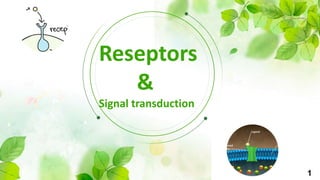
Receptors and signal transsduction along the cell membrane by Ebrahim Ragab.pptx
- 2. What is Receptors ?? receptor is a chemically reacting area of the functional macromolecules (proteins) which is located either on a cell membrane or intracellular. Types of cell receptors and signaling mechanisms 3 I-Cytoplasmic or intracellular receptors: e.g receptors of steroidal hormones (glucocorticoids, sex hormones). II- Transmembrane receptors: Receptors are located on the cell membrane e.g : ligand reseptor , G-Protein- coupled receptors
- 3. Types of reseptors Ligand gated ion channel G- proteine coupled reseptor Tyrosine kinase linked reseptor Intracellular receptors 4
- 4. (A) Ligand gated ionic channel receptors: • They are membrane receptors located on the gate of ionic channels. • Binding of ligand to the receptor will lead to conformational change in the receptor and change in cell membrane permeability to ions. • (A.Ch) + Nicotinic receptors Na+ influx depolarization Milliseconds between binding of the ligand and cellular response e.g 5
- 5. B) G. protein-coupled receptors and second messenger: They are cell surface receptors which facilitate binding of guanosine triphosphate (GTP) to specific proteins located on the cytoplasmic surface of plasma membrane known as G-protein which regulates the activity of membrane enzymes and ion channels • The G-protein is a membrane protein comprising three subunits (α, β, Ɣ) • G-protein either: -regulate intracellular 2nd messenger (α-subunits with GTPase activity) or- control opening of ion channel (β, Ɣ- subunits) 6
- 6. B) G. protein-coupled receptors and second messenger: • There are different Gα subunits (Gαs -Gαi - Gαq) i. Adenyl cyclase (A.C) is regulated via Gαs (c-AMP) and Gαi (c-AMP) ii. Phospholipase C activated via Gαq responsible for generation of IP3 (inositol triphosphate) and DAG (diacylglycerol) to regulate free calcium concentration. - Adrenaline + β-receptors,→ Gαs-protein→ ++ A.C → cAMP concentration - Adrenaline + α-2 receptors → Gαi-protein → -- A.C. → cAMP concentration • Few seconds - minutes between binding of the ligand and cellular response 7
- 7. 6 8 β,ɡ
- 8. (C) Enzyme (Tyrosine kinase)-linked receptors: 9 They are polypeptide receptors consisting of an extracellular ligand-binding domain (to which insulin or growth hormone bind). It is connected to cytoplasmic enzymatic domain containing tyrosine kinase enzyme. Which when activated will phosphorylate and activate: ii. Activator of transcription that will separate from the receptor to cross the nuclear membrane and modulate gene transcription → Genomic actions → Hours e.g. anabolic effect of insulin and growth hormone. i. Signal transducer → Non-genomic actions → Seconds – Minutes e.g. hypoglycemia of insulin.
- 9. 9 10
- 10. (D) Gene-active intracellular receptors (DNA linked receptors): They are cytosolic or nuclear receptors that modulate the transcription of genes in the nucleus leading to change in protein synthesis. • e.g. Lipid soluble ligands (steroid hormones, thyroxine , vit. D) + Intracellular receptors → DNA transcription → mRNA → change in protein synthesis. • Delayed long-lasting effect (hours between binding of the ligand and cellular response). e.g : steroid hormones 11
- 11. 12
- 13. Biological effects of drug reseptor binding 02 14 Agonist Antagonist Partial agonist Inverse agonist
- 14. 16
- 15. The drug to which the receptor has an affinity for binding with it and produces intrinsic activity and response. a-The receptor agonist 17
- 16. b-The receptor antagonist (competitive and noncompetitive) The drug to which the receptor has affinity but lacks intrinsic activity. The receptor antagonist is the drug that blocks the receptor and does not produce a response but prevents other drugs (agonists) from interacting with the receptor. 18
- 18. Reversible ,ylbisrever dniB : eht fo msilobatem yb dne tceffe antagonist e.g. Nicotine large dose, suxamethonium Irreversible ,yltnelavoc dniB : wen fo sisehtnyser yb dne tceffe receptor e.g. organophosphates, phenoxybenzamine Competitive antagonist 20
- 19. c- partial agonist: Drugs to which the receptor has an adequate affinity and produce low intrinsic activity. In absence of the full agonist, it acts as an agonist and produces only a small maximum effect. In presence of a full agonist, it 21 Ful agonist Partial agonist
- 20. d-Inverse agonist: stimulates the receptor but produces effects opposite to those obtained by the agonist. For example, beta- carbolines stimulate the same receptors (benzodiazepine receptors) but produce excitation & convulsions instead of 22
- 21. Other types of antagonist Physical : Positive "protamine" + Negative "Heparine" Chemica : Basic "gentamicine"+ acid"carpinciline" Intetaction Physiological : Adrinaline = VC Histamine = VD
- 22. . . . Other types of antagonist Pharmacokinetic s Absorption Antacids .. prevent absorbtion of IRON Metabolism Rifambin catalize mmmetabolis mof Contraseptivepill s Excretion NaHCo3 ""فوار catalize Excretion of Asprin distribution Some drugs prevents distribution of another one to the Brain
- 23. Chronic use of drug 03 14 UPREGULATION. DOWN-
- 24. a-Receptor down-regulation Decreased receptor reactivity (desensitization) to the agonist that leads to a reduction of the drug response (drug tolerance). Mechanisms of down- regulation: Reduction of the receptor number or decrease of the sensitivity of the receptors 24
- 25. Causes of down-regulation:- 1-Prolonged continuous stimulation of receptors by agonists. The sensitivity of the receptor returns to its normal level (reversible) after a period of discontinuation of the agonist. 2-Diseases: - .; continuous hyperglycemia reduces the number of insulin receptors or decrease their sensitivity to insulin. 25
- 26. b-Receptor upregulation Increased receptor reactivity (supersensitivity) to the agonist leads to exaggerated responses. Mechanism of upregulation: Increase of the number of receptors or increase of the receptor sensitivity to the agonist. 26
- 27. Causes of upregulation: 1-Prolonged use of the antagonist with the absence of the agonist. 2-Certain drugs, e.g. , , …etc. lead to the supersensitivity of receptors to . 3-Some diseases e.g. . Excess thyroxine leads to supersensitivity of beta receptors to catecholamines -Drugs associated with this phenomenon should be gradually withdrawn to avoid severe withdrawal 27
- 28. Thank you